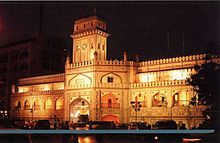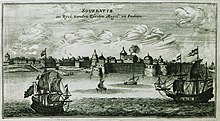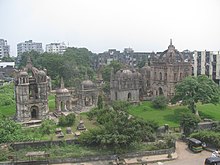History of Surat
This article may require copy editing for grammar, style, cohesion, tone, or spelling. (October 2023) |
This article needs additional citations for verification. (October 2023) |

Surat was founded in the
Medieval history

In the 12th and 15th centuries, Surat was plundered by Muslims.[3] In 1512, and again in 1530, Surat was ravaged by the Portuguese Empire. In 1514, the Portuguese traveler Duarte Barbosa described Surat as an important seaport, frequented by many ships from Malabar.[4]
Gujarat Sultanate
Several early European travellers to India make mentions about an influential Brahmin named Malik Gopi, who settled the region and founded the city.[5] It is possible that Gopi was a governor under the Gujarat Sultanate.[6] Notably, Gopi oversaw the construction of an artificial lake, known as Gopi Talav, for water storage in 1516. The area he developed was called Gopipura in his honour. For his contributions, Gopi was given the title Malik by the Sultan of Gujarat Muzaffar Shah II.[7] The town that Gopi developed was unnamed for long and after consulting astrologers he proposed to name it "Suraj" or "Suryapur". By 1520, the name of the city had become Surat[3] as the king, disliking the Hindu inclination of the name, altered it to "Surat", (alluding to the Arabic words for headings of the chapters of the Quran).[8] Gopi also finds mentions in Portuguese literature as "Lord of Surat and Bharuch".[7]
Mughal Empire
In 1573, Surat was conquered by the
Maratha Empire
Surat was sacked by Marathas twice:[11] first in January 1664 and then in October 1670.[12]
Colonial period

During the colonial period, Surat became the emporium of India, exporting gold and cloth. Its major industries were shipbuilding and textile manufacture.
In the great fire of 1837, more than 500 people died and caused the destruction of 9737 houses. It was the most destructive fire in the history of city.[14]
By the middle of the 19th century, Surat had become a stagnant city with about 80,000 inhabitants. When India's railways opened, the city started becoming prosperous again. Silks, cottons, brocades, and objects of gold and silver from Surat became famous and the ancient art of manufacturing fine muslin was revived.[3]
Post-independence
After Indian independence in 1947, several educational institutions were founded including the
See also
References
- New International Encyclopedia. Vol. XVIII. 1905. p. 714.
- ^ Malabari, Behramji (1882). Gujarat and the Gujaratis. pp. 11–37.
- ^ a b c d e f g h i "Surat". Encyclopædia Britannica. Encyclopædia Britannica, inc. 6 August 2014. Archived from the original on 10 January 2018. Retrieved 9 January 2018.
- ^ Dames Mansel Longworth (1918). Book Of Duarte Barbosa. pp. 148–149.
- ^ Barros, João de (1778). Da Asia de João de Barros e de Diogo de Couto. Brandeis University Libraries. Lisboa : Na Regia officina typografica.
- ^ Della Valle, Pietro; Havers, G. (George); Grey, Edward (1892). The travels of Pietro della Valle in India : from the old English translation of 1664. University of North Carolina at Chapel Hill University Library. London : Printed for the Hakluyt Society. p. 34.
- ^ ISBN 9788120607149.
- ^ Gazetteer of the Bombay Presidency, Volume 2. Government Central Press. 1877. p. 70.
- ^ ISBN 978-0143102625.
- ^ a b c d "History of Surat". Archived from the original on 5 January 2012.
- ^ Varadarajan, Lotika Tr (1981). India In The 17th Century Vol. 1, Part. 1.
- ^ SARKAR, JADUNATH (1916). HISTORY OF AURANGZIB VOL. 3. M. C. SARKAR AND SONS LTD. KOLKATA.
- ISBN 978-9004172029. Archivedfrom the original on 14 October 2017. Retrieved 14 October 2017.
- ^ Gujarat State Gazetteers: Surat District (2nd (Revised in 1962), 1st (1877) ed.). Ahmedabad: Directorate of Government Printing, Stationery and Publications, Gujarat State. 1962. pp. 976–978.

